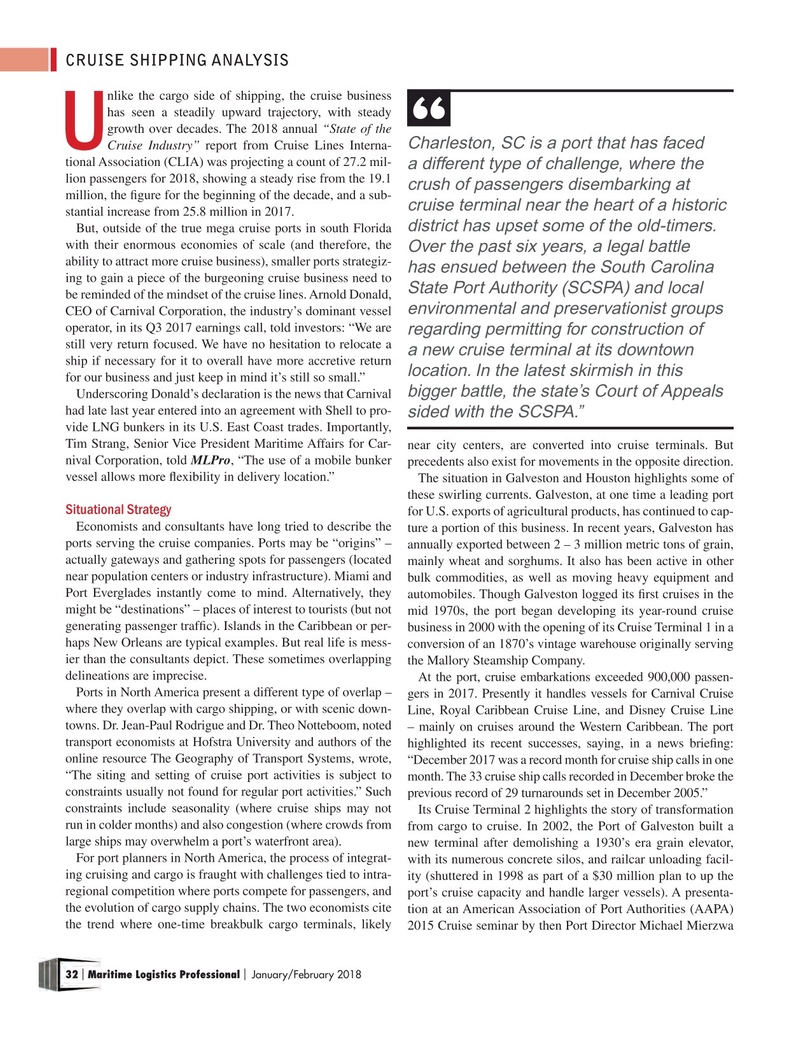
Page 32: of Maritime Logistics Professional Magazine (Jan/Feb 2018)
Cruise Shipping Trends
Read this page in Pdf, Flash or Html5 edition of Jan/Feb 2018 Maritime Logistics Professional Magazine
CRUISE SHIPPING ANALYSIS nlike the cargo side of shipping, the cruise business has seen a steadily upward trajectory, with steady growth over decades. The 2018 annual “State of the
Charleston, SC is a port that has faced
UCruise Industry” report from Cruise Lines Interna- tional Association (CLIA) was projecting a count of 27.2 mil- a different type of challenge, where the lion passengers for 2018, showing a steady rise from the 19.1 crush of passengers disembarking at million, the ? gure for the beginning of the decade, and a sub- cruise terminal near the heart of a historic stantial increase from 25.8 million in 2017.
district has upset some of the old-timers.
But, outside of the true mega cruise ports in south Florida with their enormous economies of scale (and therefore, the
Over the past six years, a legal battle ability to attract more cruise business), smaller ports strategiz- has ensued between the South Carolina ing to gain a piece of the burgeoning cruise business need to
State Port Authority (SCSPA) and local be reminded of the mindset of the cruise lines. Arnold Donald, environmental and preservationist groups
CEO of Carnival Corporation, the industry’s dominant vessel operator, in its Q3 2017 earnings call, told investors: “We are regarding permitting for construction of still very return focused. We have no hesitation to relocate a a new cruise terminal at its downtown ship if necessary for it to overall have more accretive return location. In the latest skirmish in this for our business and just keep in mind it’s still so small.” bigger battle, the state’s Court of Appeals
Underscoring Donald’s declaration is the news that Carnival had late last year entered into an agreement with Shell to pro- sided with the SCSPA.” vide LNG bunkers in its U.S. East Coast trades. Importantly,
Tim Strang, Senior Vice President Maritime Affairs for Car- near city centers, are converted into cruise terminals. But nival Corporation, told MLPro, “The use of a mobile bunker precedents also exist for movements in the opposite direction. vessel allows more ? exibility in delivery location.”
The situation in Galveston and Houston highlights some of these swirling currents. Galveston, at one time a leading port
Situational Strategy for U.S. exports of agricultural products, has continued to cap-
Economists and consultants have long tried to describe the ture a portion of this business. In recent years, Galveston has ports serving the cruise companies. Ports may be “origins” – annually exported between 2 – 3 million metric tons of grain, actually gateways and gathering spots for passengers (located mainly wheat and sorghums. It also has been active in other near population centers or industry infrastructure). Miami and bulk commodities, as well as moving heavy equipment and
Port Everglades instantly come to mind. Alternatively, they automobiles. Though Galveston logged its ? rst cruises in the might be “destinations” – places of interest to tourists (but not mid 1970s, the port began developing its year-round cruise generating passenger traf? c). Islands in the Caribbean or per- business in 2000 with the opening of its Cruise Terminal 1 in a haps New Orleans are typical examples. But real life is mess- conversion of an 1870’s vintage warehouse originally serving ier than the consultants depict. These sometimes overlapping the Mallory Steamship Company.
delineations are imprecise.
At the port, cruise embarkations exceeded 900,000 passen-
Ports in North America present a different type of overlap – gers in 2017. Presently it handles vessels for Carnival Cruise where they overlap with cargo shipping, or with scenic down-
Line, Royal Caribbean Cruise Line, and Disney Cruise Line towns. Dr. Jean-Paul Rodrigue and Dr. Theo Notteboom, noted – mainly on cruises around the Western Caribbean. The port transport economists at Hofstra University and authors of the highlighted its recent successes, saying, in a news brie? ng: online resource The Geography of Transport Systems, wrote, “December 2017 was a record month for cruise ship calls in one “The siting and setting of cruise port activities is subject to month. The 33 cruise ship calls recorded in December broke the constraints usually not found for regular port activities.” Such previous record of 29 turnarounds set in December 2005.” constraints include seasonality (where cruise ships may not
Its Cruise Terminal 2 highlights the story of transformation run in colder months) and also congestion (where crowds from from cargo to cruise. In 2002, the Port of Galveston built a large ships may overwhelm a port’s waterfront area). new terminal after demolishing a 1930’s era grain elevator,
For port planners in North America, the process of integrat- with its numerous concrete silos, and railcar unloading facil- ing cruising and cargo is fraught with challenges tied to intra- ity (shuttered in 1998 as part of a $30 million plan to up the regional competition where ports compete for passengers, and port’s cruise capacity and handle larger vessels). A presenta- the evolution of cargo supply chains. The two economists cite tion at an American Association of Port Authorities (AAPA) the trend where one-time breakbulk cargo terminals, likely 2015 Cruise seminar by then Port Director Michael Mierzwa 32 Maritime Logistics Professional January/February 2018 | |

 31
31

 33
33
